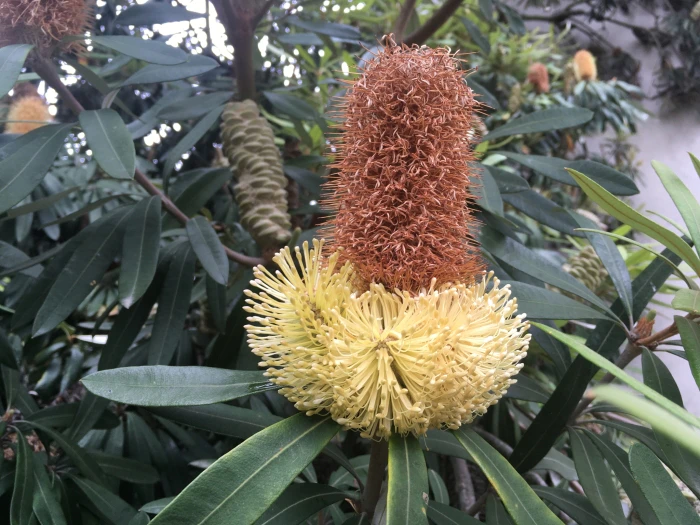Coastal Banksia
(Banksia integrifolia)
Coastal Banksia (Banksia integrifolia)
/
/

© Jon Sullivan
CC BY 4.0
Image By:
© Jon Sullivan
Recorded By:
Copyright:
CC BY 4.0
Copyright Notice:
Photo by: © Jon Sullivan | License Type: CC BY 4.0 | License URL: http://creativecommons.org/licenses/by/4.0/ | Uploader: jon_sullivan | Publisher: iNaturalist |























Estimated Native Range
Climate Requirements for Chino, California
| This Plant | Your Site | Plant Suitability for Your Location | ||
|---|---|---|---|---|
| • Precipitation | 11" - 165" | 15" | Your precipitation may be insufficient for this plant. Irrigate N" / year. | Irrigate N" / year |
| • High Temp. | 66°F - 93°F | 91°F | Your summer temperatures are normal for this plant. | Excellent |
| • Low Temp. | 24°F - 64°F | 41°F | Your winter temperatures are normal for this plant | Excellent |
This plant should grow well at your location with about N inches per year (Y minutes per month) of irrigation.
Summary
Banksia integrifolia, commonly known as Coastal Banksia, is an evergreen tree or large shrub native to coastal areas and coastal forests of eastern Australia, from Victoria to Central Queensland. It can grow up to 50 feet (15 meters) tall with a spread of 10-20 feet (3-6 meters), featuring a dense canopy and smooth, pale gray bark. The leaves are dark green above with white undersides, contributing to its distinctive appearance. Coastal Banksia produces cylindrical pale yellow flower spikes, known as inflorescences, which are highly attractive to nectar-feeding birds and insects, especially during its flowering season from late summer to winter. The flowers are followed by woody seed cones that can persist on the plant for years.
Coastal Banksia is valued for its adaptability to poor sandy soils, tolerance to salt spray, and low water requirements once established, making it an excellent choice for coastal plantings and gardens with similar harsh conditions. It is also used as a windbreak, for erosion control, and in habitat restoration projects. In cultivation, it prefers full sun to part shade and well-drained soils. While generally low-maintenance, it can be affected by root rot in poorly drained conditions and may require protection from frost in cooler climates. Coastal Banksia is also popular for use in cut flower arrangements due to its long-lasting and showy flower spikes.CC BY-SA 4.0
Coastal Banksia is valued for its adaptability to poor sandy soils, tolerance to salt spray, and low water requirements once established, making it an excellent choice for coastal plantings and gardens with similar harsh conditions. It is also used as a windbreak, for erosion control, and in habitat restoration projects. In cultivation, it prefers full sun to part shade and well-drained soils. While generally low-maintenance, it can be affected by root rot in poorly drained conditions and may require protection from frost in cooler climates. Coastal Banksia is also popular for use in cut flower arrangements due to its long-lasting and showy flower spikes.CC BY-SA 4.0
Plant Description
- Plant Type: Shrub, Tree
- Height: 10-30 feet
- Width: 8-30 feet
- Growth Rate: Moderate
- Flower Color: Brown, Yellow
- Flowering Season: Spring, Summer, Fall
- Leaf Retention: Evergreen
Growth Requirements
- Sun: Full Sun
- Water: Low, Medium
- Drainage: Fast, Medium
Common Uses
Bird Garden, Butterfly Garden, Drought Tolerant, Hedges, Low Maintenance, Showy Flowers, Street Planting
Natural Habitat
Native to coastal areas and coastal forests of eastern Australia
Other Names
Common Names: Coastal Banksia , Honeysuckle-Oak , White Banksia , White Bottlebrush , White Honeysuckle
Scientific Names: Banksia integrifolia , Banksia integrifolia var. integrifolia , Banksia integrifolia var. typica
GBIF Accepted Name: Banksia integrifolia